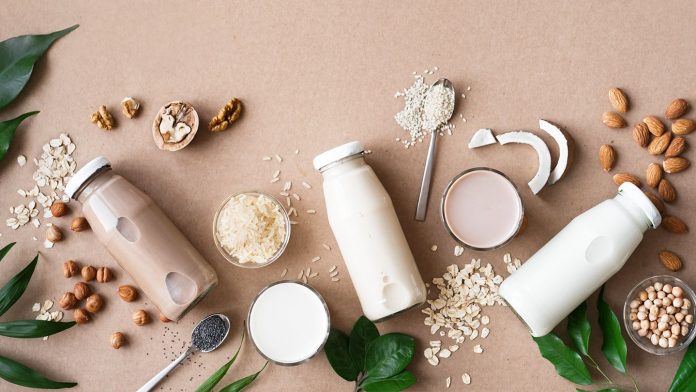These yummy foods are packed with fat and flavor.
Healthy high-fat foods are a wonderful way to incorporate more flavor, satisfaction, and nutrition into every snack and meal. Along with making food taste richer and more tasty, of course, this macronutrient rocks for a few reasons. But before getting into a lengthy, mouthwatering list of fantastic high-fat superfoods to incorporate into your diet (many of which you probably already have in your pantry or fridge), let’s touch on the benefits of fat and the different types.
The importance of giving fat a place in our diets may seem like common nutrition knowledge today. But before the days of the keto diet, high-carb low-fat foods and high-protein low-fat foods were widely considered better for you than any high-fat foods. The truth is that healthwise, fats play a vital role in numerous body functions, like cell growth and turnover, brain growth and development, and digestion, as SELF has reported. Fats are also responsible for keeping us full and satisfied for longer periods of time. Plus, a lot of good fat sources are also naturally rich in other essential nutrients, like fiber, protein, and a range of vitamins and minerals.
What do people mean when they talk about healthy high-fat foods, though, as opposed to unhealthy ones? First of all, it can be dicey to divide foods into discrete categories of “healthy” or “unhealthy.” Our tendency to label foods this way is a practice supported by diet culture as much as (or more than) science, and generally speaking, all foods can have a place in a varied, balanced diet. Also, like many topics in nutrition, the research into the effects of the various types of fats on our health is evolving, and sometimes a source of disagreement among experts.
That said, people generally use the term healthy fats as a simple way to refer to the unsaturated fats that we know are great for us, and unhealthy fats to refer to the saturated fats you may want to moderate. Here’s a brief rundown of saturated versus unsaturated fats. (And if you want a more in-depth primer on the topic—along with answers to questions like how many grams of fat per day is ideal—check this piece out.)
Fats considered ‘healthy’
The science here is actually pretty substantial—these are the types of healthy fats we generally want more of. There are two kinds:
Monounsaturated fats: “These are among the healthiest of all fats,” Dana Hunnes, PhD, MPH, RD, senior dietitian at UCLA Medical Center and adjunct assistant professor at the Fielding School of Public Health, tells SELF. Monounsaturated fats help develop and maintain your cells, and can help lower your LDL cholesterol levels, reducing your risk of heart disease and stroke, the U.S. National Library of Medicine says. They are found in foods like olive oil, nuts, and avocados (some of the best high-fat foods for vegetarians).
Polyunsaturated fats: The two main types of polyunsaturated fats are omega-3 and omega-6 fatty acids, which our bodies cannot make on their own but need for many essential functions, the American Heart Association (AHA) explains. Omega-3 fatty acids especially are beneficial for heart health, including reducing blood pressure and decreasing cholesterol and triglyceride levels, according to the U.S. National Library of Medicine. Omega-3s are mostly found in foods like fish, nuts, and seeds, while omega-6s are found in certain plant-based oils, Hunnes says.
Fats experts recommend eating less
Although the science here is less clear-cut, there are two main types of fats that are not thought to be as healthy. Nutrition and public health experts generally advise either minimizing or moderating your intake of them. There are two kinds:
What It’s Like to Live With Heart Failure Through the Five Senses
Saturated fats: The guidance on saturated fat can be complicated. If you’ve ever wondered, “Is saturated fat bad?” the answer isn’t so straightforward. Old nutrition research said saturated fat was bad for your cholesterol levels and cardiovascular risk, but newer information suggests it may have a more neutral effect. While the topic is far from settled, currently the USDA Dietary Guidelines and the AHA do still recommend limiting your intake of saturated fats—found in animal products like beef, lamb, pork, butter, and cheese, as well as fried foods and baked goods—and opting for monounsaturated and polyunsaturated fats whenever possible.
Trans fats: The evidence here is more clear: Trans fats raise your LDL cholesterol and lower your HDL cholesterol (the kind that helps keep blood vessels clear), per the AHA. They can also increase your risk of developing heart disease and stroke, and are associated with a higher risk of type 2 diabetes. The AHA advises minimizing your consumption of foods high in trans fat (like fried foods and baked goods that contain partially hydrogenated oils).
Okay, now that we know exactly what we’re talking about when we talk about healthy high-fat foods, here’s a list of deliciously fatty, nutritious foods you can add to your plate.
1. Avocados
The scoop: One medium avocado has about about 21 grams of fat. These creamy, green sources of fat are also bursting with 9 grams of fiber in just one avocado.
2. Walnuts
The scoop: With 21 grams of fat in a 1-oz. serving, walnuts are a fantastic source of omega-3 and omega-6 fatty acids. They’re also rich in the minerals manganese and copper.
3. Almonds
The scoop: Nuts in general are packed with fat. While it’s hard to go wrong with any kind, we’re big fans of almonds, which have 15 grams of fat in a 1-oz. serving (about 22 nuts) and are rich in vitamin E.
4. Nut and seed butters
The scoop: If you love the flavor of nuts, but not the crunch, consider nut butters. They’re creamy and spreadable, and yet full of all the same nutrients as their unblended counterpart. And that includes plenty of healthy fats! Beyond peanut butter, try almond, cashew, or sunflower seed butter for a plant-based dose of creamy fat (plus fiber and protein). For example, there are 16 grams of fat in two tablespoons of both PB and sunflower seed butter.
5. Olives
The scoop: They may be small, but all of the countless varieties of olives are rich in fat and flavor. Just 1-oz. of green olives (about 14 olives) has 4 grams of fat.
6. Olive oil
The scoop: We all know the oil pressed from olives is a tremendous source of healthy fats. Just one tablespoon of the stuff, a go-to oil in many people’s kitchens, has 14 grams of fat.
7. Ground flaxseed
The scoop: Flaxseed is a great source of those omega-3 fatty acids and packs about 8 grams of fat per ounce. Flaxseed also contains both insoluble and soluble fiber, which are good for feeling satiated, digestive health, stabilizing blood sugar, and regular poops, as SELF has previously reported.
8. Salmon
The scoop: Oily fish like salmon is full of omega-3 fatty acids—whether it’s smoked, baked, raw, or pan-seared. A cooked 3-oz. filet of Atlantic salmon has 11 grams of fat.
9. Tuna
The scoop: Tuna is another type of fish that’s packed with a particularly high amount of healthy fats and omega-3s. We’re talking about both the inexpensive and conveniently canned stuff (about 5 grams in one regular can), and the kind you find at your favorite Japanese spot (about 5 grams in 3 ounces, cooked).
10. Dark chocolate
The scoop: A 1-oz. portion of delicious dark chocolate boasts around 11 grams of fat, plus a bonus 2 grams of fiber.
11. Tofu
The scoop: Tofu is beloved by vegetarians and vegans alike because it’s a solid source of healthy fats and plant-based protein. (What is protein? This nutrient also contributes to feelings of fullness as well as helping your muscles heal after physical exercise.) This ingredient isn’t as high in fat as some other foods on this list, but you’ll still get roughly 4 grams of fat from a 3-oz. portion of super-firm tofu.
12. Edamame
The scoop: Since tofu’s on the list, we clearly can’t leave out the plant that is used to make it! With 4.5 grams of fat in a half cup of shelled edamame, this young soybean is also a great source of plant-based protein (9 grams a serving) and fiber (4 grams a serving).
13. Sunflower seeds
The scoop: A 2-Tbsp. serving of these flavorful, crunchy little guys delivers about 14 grams of fat, along with 6 grams of protein and 2 grams of fiber.
14. Chia seeds
The scoop: These small but mighty seeds have fiber, protein, essential minerals, and, of course, fat—6 grams of the stuff per 2 tablespoons, including lots of omega-3 and omega-6 fatty acids.
15. Eggs
The scoop: Everyone knows eggs are an inexpensive and easy source of protein. And if you don’t get rid of the yolk, they’re a great source of fat too. One extra-large whole egg contains 6 grams of fat. Sometimes people opt for egg whites only, but the yolk is packed with rich flavor and important vitamins and minerals along with the fat, such as selenium and choline. (As for cholesterol in egg yolks: The latest nutrition research has found that egg yolks can be included in a healthy diet and don’t typically impact cholesterol levels in a significant way.)
16. Full-fat dairy
The scoop: Since fat in general is satiating, the fat in protein-packed dairy is no exception. Opting for full-fat dairy can result in the type of satisfaction you might be missing with lower-fat versions. Whole milk and full-fat yogurt each contain 8 grams of fat (with 5 grams of saturated fat) per cup, plus a whole lot of richness and creaminess.
17. Hemp seeds
The scoop: Hemp seeds are a lovely, underrated little seed. They have a nutty taste, creamy texture, and 15 grams of fat in a serving (3 tablespoons), plus 9 grams of protein to boot.
18. Shredded coconut
The scoop: Coconut comes in many delicious forms—milk, cream, water, oil, fresh meat, and dried flakes. Sweetened or unsweetened shredded coconut flakes pack 8 grams of fat per ounce, and a lot of tropical flavor. But the other forms are similarly high in healthy fast as well.
19. Anchovies
The scoop: When you’re thinking about fish full of healthy fats, it’s easy to forget about anchovies. One small 2-oz. can of these briny little fishes, drained, has 4.5 grams of fat—more if you don’t completely drain them—plus a whopping 13 grams of protein.
20. Pumpkin seeds
The scoop: Pumpkin seeds, or pepitas, have 13 grams of fat per ounce—along with 7 grams of protein and quite a bit of the minerals iron, magnesium, phosphorus, copper, and manganese.




























